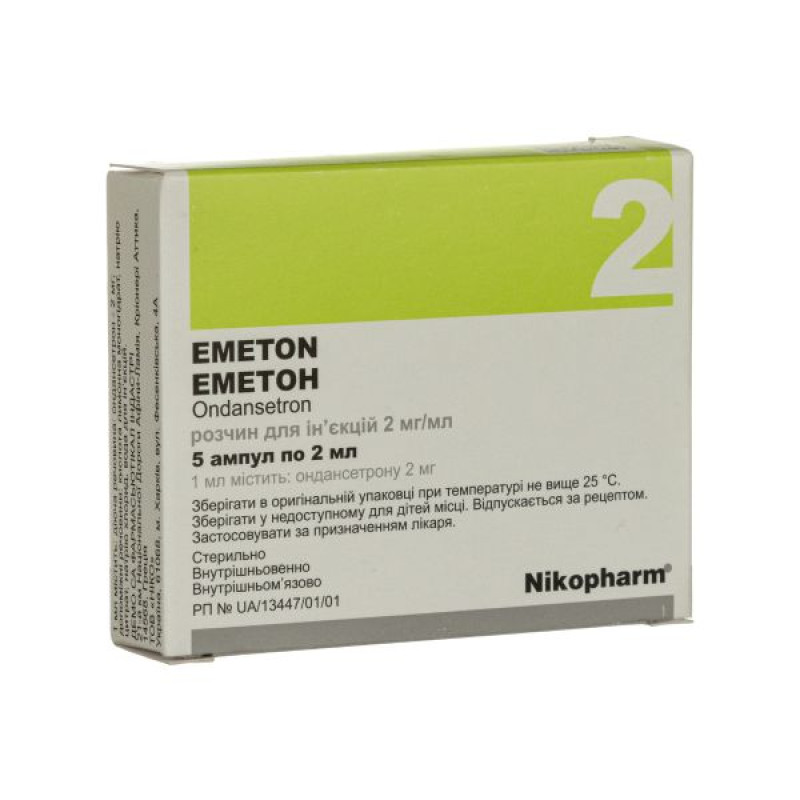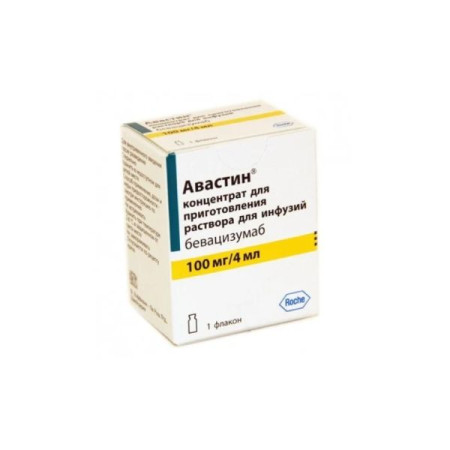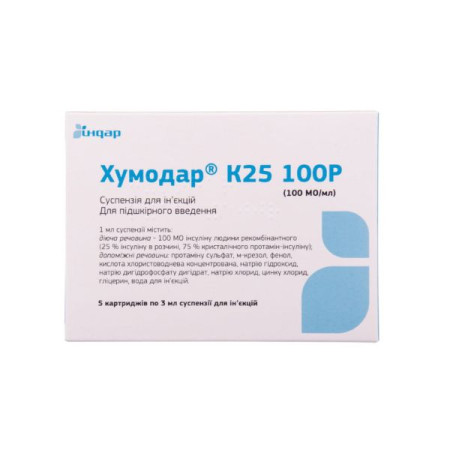Emeton solution for injection 2 mg/ml ampoule 2 ml No. 5

Pharmacological properties
Pharmacodynamics. Ondansetron is a potent, highly selective antagonist of 5HT3 (serotonin) receptors. The drug prevents or eliminates nausea and vomiting caused by cytotoxic chemotherapy and/or radiotherapy, as well as postoperative nausea and vomiting. The mechanism of action of ondansetron is not fully understood. It is possible that the drug blocks the occurrence of the vomiting reflex, exhibiting an antagonistic effect on 5HT3 receptors, which are localized in neurons of both the peripheral and central nervous systems. The drug does not reduce the patient's psychomotor activity and does not have a sedative effect.
Pharmacokinetics. With i / m administration, C max in blood plasma is achieved within 10 minutes. The volume of distribution after parenteral administration in adults is 140 l. The main part of the administered dose is metabolized in the liver. Less than 5% of the drug is excreted unchanged in the urine. T ½ - about 3 hours (in elderly patients - 5 hours). Binding to blood plasma proteins - 70-76%.
In patients with moderate renal insufficiency (creatinine clearance 15-60 ml/min), both the systemic clearance and the volume of distribution of ondansetron are reduced, resulting in a slight and clinically insignificant increase in T½ of the drug. The pharmacokinetics of ondansetron are practically unchanged in patients with severe renal insufficiency on chronic hemodialysis. In individuals with severe chronic liver insufficiency, the systemic clearance of ondansetron is markedly reduced with an increase in T½ (15-32 hours).
Indication
Nausea and vomiting caused by cytotoxic chemotherapy and radiotherapy. Prevention and treatment of postoperative nausea and vomiting.
Application
Nausea and vomiting caused by chemotherapy and radiation therapy
The emetogenic potential of cancer therapy varies depending on the dose and combination of chemotherapy and radiotherapy regimens. The choice of dosing regimen depends on the severity of the emetogenic effect.
adults
Emetogenic chemotherapy and radiation therapy
The recommended IV or IM dose of Emeton is 8 mg as a slow injection over at least 30 seconds, immediately before treatment.
For the prevention of delayed or prolonged vomiting after the first 24 hours, oral or rectal administration of the drug is recommended.
Highly emetogenic chemotherapy (e.g. high-dose cisplatin)
Emeton can be administered as a single dose of 8 mg IV or IM immediately before chemotherapy. Doses above 8 mg (up to 16 mg) can only be administered as an IV infusion in 50-100 ml of 0.9% sodium chloride solution or other suitable diluent (see Instructions for Use); the infusion should last at least 15 minutes. A single dose exceeding 16 mg should not be administered (see Precautions).
For highly emetogenic chemotherapy, Emeton ≤8 mg does not require dilution and can be administered by slow IV or IM injection (at least 30 s) immediately before chemotherapy, followed by two IV or IM injections of 8 mg 2 and 4 hours later or by a continuous infusion of 1 mg/h for 24 hours.
The effectiveness of Emeton in highly emetogenic chemotherapy can be increased by additional single administration of dexamethasone sodium phosphate at a dose of 20 mg before chemotherapy.
For the prevention of delayed or prolonged vomiting after the first 24 hours, oral or rectal administration of the drug is recommended.
Children and adolescents (ages 6 months to 17 years)
In pediatric practice, Emeton should be administered by intravenous infusion in 25-50 ml of 0.9% sodium chloride solution or other suitable solvent (see Instructions for Use) for at least 15 minutes. The dose of the drug can be calculated based on the body surface area or body weight of the child.
Calculation of dose based on the child's body surface area
Emeton should be administered immediately before chemotherapy by a single intravenous injection at a dose of 5 mg/m2, the intravenous dose should not exceed 8 mg. After 12 hours, oral administration of the drug can be started, which can last for another 5 days. Do not exceed the adult dose.
Calculation of the dose by the child's body weight
Emeton should be administered immediately before chemotherapy by a single intravenous injection at a dose of 0.15 mg/kg body weight. The intravenous dose should not exceed 8 mg. On the first day, two more intravenous doses can be administered with a 4-hour interval. After 12 hours, oral administration of the drug can be started, which can last for another 5 days. Do not exceed the adult dose.
Elderly patients
For patients aged 65 years and over, all doses for intravenous injections should be dissolved and administered within 15 minutes; with repeated use, the interval between injections should be at least 4 hours.
In patients aged 65 to 74 years, the initial dose of ondansetron is 8 or 16 mg, administered by intravenous infusion over 15 minutes, which can be continued by administering two doses of 8 mg over 15 minutes with an interval between infusions of at least 4 hours.
In patients aged 75 years and older, the initial IV injection of ondansetron should not exceed 8 mg infused over at least 15 minutes. After an initial dose of 8 mg, administration may be continued with two 8 mg doses administered by infusion over 15 minutes with an interval of at least 4 hours between infusions.
Patients with renal insufficiency
There is no need to change the dosage regimen or route of administration in patients with renal impairment.
In patients with moderate and severe liver dysfunction, the clearance of Emeton is significantly reduced, and T½ from serum is increased. For such patients, the maximum daily dose of the drug should not exceed 8 mg.
Patients with impaired metabolism of sparteine/debrisoquine
The half-life of ondansetron in patients with impaired metabolism of sparteine and debrisoquine is not altered. In these patients, repeated administration results in the same drug concentration as in patients with intact metabolism. Therefore, no change in dosage or frequency of administration is required.
Postoperative nausea and vomiting
adults
For the prevention of postoperative nausea and vomiting, the recommended dose of Emeton is 4 mg as a single IM or slow IV injection during induction of anesthesia.
For the treatment of postoperative nausea and vomiting, the recommended single dose of Emeton is 4 mg as an intramuscular or slow intravenous injection.
Children and adolescents (1 month to 17 years)
For the prevention and treatment of postoperative nausea and vomiting in children undergoing surgery under general anesthesia, Emeton can be administered at a dose of 0.1 mg/kg body weight (maximum - up to 4 mg) as a slow intravenous injection (at least 30 s) before, during, after induction of anesthesia or after surgery.
Elderly patients
Experience with the use of Emeton for the prevention and treatment of postoperative nausea and vomiting in the elderly is limited, however, Emeton is well tolerated by patients over 65 years of age receiving chemotherapy.
Patients with renal insufficiency
There is no need to change the dosage regimen or route of administration in patients with renal impairment.
Patients with hepatic insufficiency
In patients with moderate and severe hepatic impairment, the clearance of Emeton is significantly reduced and the serum half-life is increased. For such patients, the maximum daily dose of the drug should not exceed 8 mg.
Patients with impaired metabolism of sparteine/debrisoquine
T½ of ondansetron in individuals with impaired metabolism of sparteine and debrisoquine is not changed. In such patients, repeated administration results in the same concentration of the drug as in patients with intact metabolism. Therefore, a change in dosage or frequency of administration is not required.
Instructions for use
Emeton ampoules do not contain preservatives and should be used immediately after opening; any remaining solution should be discarded.
Ampoules with Emeton cannot be autoclaved.
Compatibility with other fluids for intravenous injection
Solutions for intravenous infusion should be prepared immediately before infusion. However, ondansetron solution has been shown to be stable for 7 days at room temperature (up to 25°C) in daylight or in a refrigerator when dissolved in the following media: 0.9% sodium chloride solution, 5% glucose solution, 10% mannitol solution, Ringer's solution, 0.3% potassium chloride solution and 0.9% sodium chloride solution, 0.3% potassium chloride solution and 5% glucose solution.
Ondansetron has been shown to be stable in polyethylene and glass vials. Ondansetron is known to be stable in polypropylene syringes when diluted with 0.9% sodium chloride or 5% glucose. Stability in polypropylene syringes has also been shown to be stable when diluted with other recommended solutions.
If long-term storage of the drug is necessary, dissolution should be carried out under appropriate aseptic conditions.
Compatibility with other drugs
Emeton can be administered as an IV infusion at a rate of 1 mg/h. Via a Y-injector together with Emeton at an ondansetron concentration of 16 to 160 μg/ml (i.e. 8 mg/500 ml or 8 mg/50 ml respectively) the following can be administered:
- cisplatin at a concentration of up to 0.48 mg/ml, for 1-8 hours;
- 5-fluorouracil at a concentration of up to 0.8 mg/ml (e.g. 2.4 g in 3 l or 400 mg in 500 ml) at a rate of not more than 20 ml/h. Higher concentrations of 5-fluorouracil may cause precipitation of ondansetron. 5-fluorouracil infusion solutions may contain up to 0.045% magnesium chloride in addition to other compatible excipients;
- carboplatin at a concentration of 0.18 mg/ml to 9.9 mg/ml (e.g. 90 mg in 500 ml to 990 mg in 100 ml) for 10-60 minutes;
- etoposide at a concentration of 0.14 mg/ml to 0.25 mg/ml (e.g. 72 mg in 500 ml to 250 mg in 1 l) over 30-60 min;
- ceftazidime in a dose of 250 mg to 2 g, diluted in water for injection (for example, 2.5 ml for 250 mg or 10 ml for 2 g of ceftazidime) as a bolus injection over 5 minutes;
- cyclophosphamide in a dose of 100 mg to 1 g, diluted in water for injection (5 ml per 100 mg of cyclophosphamide), as an intravenous bolus injection over 5 minutes;
- doxorubicin in a dose of 10 to 100 mg, diluted in water for injection (5 ml per 10 mg of doxorubicin), as an intravenous bolus injection over 5 minutes;
- dexamethasone at a dose of 20 mg, as a slow IV injection over 2-5 min (with simultaneous administration of 8 mg or 16 mg of ondansetron dissolved in 50-100 ml of injection solution), for approximately 15 min. Since these drugs are compatible, they can be administered through one dropper, while the concentration of dexamethasone phosphate (in the form of sodium salt) in the solution will be from 32 μg to 2.5 mg per 1 ml, and ondansetron - from 8 μg to 1 mg per 1 ml.
Contraindication
Ondansetron is not recommended in combination with apomorphine hydrochloride, since cases of severe hypotension and loss of consciousness have been reported during their simultaneous use. Hypersensitivity to any component of the drug.
The side effects, information about which is given below, are classified by organs and systems and by frequency of occurrence. The frequency of occurrence is divided into the following categories: very often (≥1/10), often (≥1/100 and 1/10), infrequently (≥1/1000 and 1/100), rarely (≥1/10,000 and 1/1000), very rarely (1/10,000).
On the part of the immune system: immediate-type hypersensitivity reactions, sometimes severe, up to anaphylaxis.
Nervous system: headache; convulsions, movement disorders (including extrapyramidal reactions such as oculogyric crisis, dystonic reactions and dyskinesia without persistent clinical consequences); dizziness mainly during rapid intravenous administration of the drug.
On the part of the organ of vision: transient visual disturbances (clouding of the eyes), mainly with intravenous administration; transient blindness, mainly with intravenous administration. In most cases, blindness resolves within 20 minutes.
Cardiac: arrhythmia, chest pain (with or without ST segment depression), bradycardia; QT prolongation (including ventricular flutter/fibrillation (torsade de pointes).
Vascular: feeling of warmth or flushing; hypotension.
Respiratory and thoracic disorders: hiccups.
Gastrointestinal tract: constipation.
Hepatobiliary system: asymptomatic increase in liver function tests. These cases are noted mainly in patients treated with chemotherapeutic drugs containing cisplatin.
Skin and subcutaneous tissue disorders: toxic eruptions, including toxic epidermal necrolysis.
General disorders: local reactions at the site of intravenous administration.
The following adverse reactions have been reported from post-marketing surveillance.
Cardiovascular system: chest pain and discomfort, extrasystoles, tachycardia, including ventricular and supraventricular tachycardia, atrial fibrillation, palpitations, syncope, ECG changes.
Hypersensitivity reactions: anaphylactic reactions, angioedema, bronchospasm, anaphylactic shock, itching, skin rashes, urticaria.
Nervous system disorders: gait disturbance, chorea, myoclonus, restlessness, burning sensation, tongue protrusion, diplopia, paresthesia.
General disorders and local reactions: fever, pain, redness, burning at the injection site.
Other: hypokalemia.
Special instructions
Hypersensitivity reactions have been observed in patients with hypersensitivity to other selective 5HT3 receptor antagonists.
Ondansetron prolongs the QT interval in a dose-dependent manner (see Pharmacological properties). Additionally, post-marketing reports of ventricular fibrillation/flutter (torsade de pointes) have been reported with ondansetron. Ondansetron should be avoided in patients with congenital long QT syndrome. Ondansetron should be used with caution in patients who have or may develop QT prolongation, including patients with electrolyte imbalance, congestive heart failure, bradyarrhythmia, or patients receiving other drugs known to prolong the QT interval or electrolyte imbalance. Hypokalemia and hypomagnesemia should be corrected before administration.
Serotonin syndrome has been reported following concomitant use of ondansetron and other serotonergic drugs (see Interactions). If concomitant treatment with ondansetron and other serotonergic drugs is clinically warranted, appropriate monitoring of the patient is recommended.
Since ondansetron weakens intestinal peristalsis, careful monitoring of patients with signs of subacute intestinal obstruction is necessary during the use of Emeton.
In patients undergoing adenotonsillar surgery, the use of ondansetron for the prevention of nausea and vomiting may mask the occurrence of bleeding. Therefore, these patients should be carefully monitored after the use of ondansetron.
Use during pregnancy and breastfeeding. Ondansetron is not used during these periods due to limited data on its safety during pregnancy and breastfeeding. Ondansetron is able to penetrate into breast milk. If the use of the drug is necessary, breastfeeding should be discontinued.
Children. The drug is prescribed to children from 6 months of age during chemotherapy and from 1 month of age - for the prevention of treatment of postoperative nausea and vomiting.
The ability to influence the reaction rate when driving vehicles or working with other mechanisms. Ondansetron does not have a sedative effect, however, the side effect profile of the drug should be taken into account when driving vehicles or working with other mechanisms.
Interactions
Ondansetron does not accelerate or inhibit the metabolism of other drugs when used simultaneously with it. Special studies have shown that ondansetron does not interact with alcohol, temazepam, furosemide, alfentanil, tramadol, morphine, lignocaine, thiopental or propofol.
Ondansetron should be used with caution in combination with drugs that prolong the QT interval and/or cause electrolyte imbalance (see Precautions).
apomorphine
The use of ondansetron with apomorphine hydrochloride is contraindicated, as cases of severe hypotension and loss of consciousness have been observed during concomitant use.
Phenytoin, carbamazepine, and rifampicin
In patients treated with potential CYP 3A4 inducers (e.g. phenytoin, carbamazepine and rifampicin), the clearance of ondansetron is increased and its blood concentration is reduced.
Serotoninergics (e.g. selective serotonin reuptake inhibitors and serotonin-norepinephrine reuptake inhibitors)
Serotonin syndrome (including mental status changes, autonomic instability, and neuromuscular disorders) has been described following concomitant use of ondansetron and other serotonergic drugs, including selective serotonin reuptake inhibitors and serotonin-norepinephrine reuptake inhibitors (see Precautions).
tramadol
According to a small number of clinical studies, ondansetron may reduce the analgesic effect of tramadol.
The use of Emeton with other drugs that prolong the QT interval may cause additional prolongation of this interval. The simultaneous use of Emeton with cardiotoxic drugs (e.g. anthracyclines) may increase the risk of arrhythmias (see Precautions).
Incompatibility: Ondansetron should not be mixed in the same syringe or infusion solution with other drugs, except those specified in the USAGE section.
Overdose
There is insufficient data on cases of overdose with ondansetron. In most cases, the symptoms are similar to those described in patients who were administered the drug at recommended doses (see side effects).
Ondansetron prolongs the QT interval in a dose-dependent manner. ECG monitoring is recommended in case of overdose.
Symptoms of overdose have included visual disturbances, severe constipation, hypotension, and vasovagal reactions with transient second-degree AV block. In all cases, these symptoms resolved completely.
There is no specific antidote, therefore, in cases of overdose, symptomatic and supportive therapy should be used.
The use of ipecacuanha in ondansetron overdose is not recommended because its effect may not be manifested due to the antiemetic effect of ondansetron.
Storage conditions
In the original packaging at a temperature not exceeding 25 °C.
There are no reviews for this product.
There are no reviews for this product, be the first to leave your review.
No questions about this product, be the first and ask your question.











